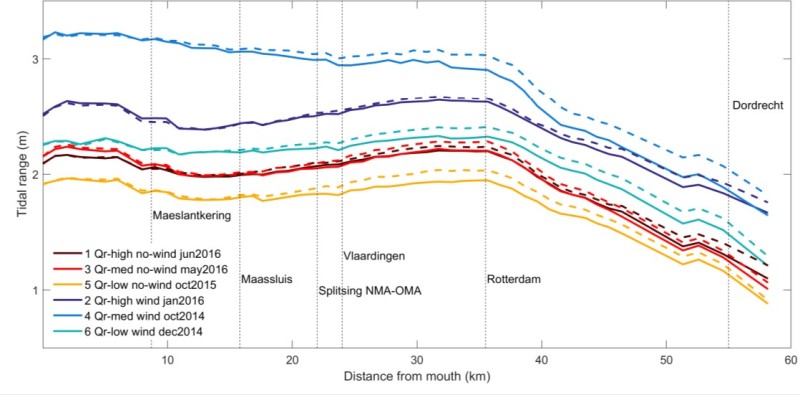I. Niesten1*, J.R.F.W. Leuven1,2, Y. Huismans3,4, J.R. Cox5, L.H. Hulsen6, T. van der Kaaij3, A.J.F. Hoitink1
1 Environmental Sciences group, Wageningen UR; 2 Resilience & Maritime (Water), Royal HaskoningDHV; 3 Marine and Coastal systems, Deltares; 4 Civil Engineering and Geosciences, TU Delft; 5 Faculty of Geosciences, Utrecht University; 6 Port of Rotterdam.
*corresponding author:
Sea level rise (SLR) is predicted to accelerate in the coming decades. With globally decreasing sediment supplies, sedimentation cannot keep pace with SLR and many estuaries and deltas are at the risk of becoming deeper. At the same time, many estuarine channels are artificially deepened for navigation purposes. These factors potentially favour amplification of the tides through reduced friction. As a result, the increase of peak water levels may exceed mean sea level rise in deepened channels, leading to a higher flood risk in these areas. The extent of this effect however is largely unknown, and other mechanisms affecting tidal amplification may be relevant. Here, we investigate the tidal response to increasing channel depths by both SLR and artificial deepening in the Rhine-Meuse Estuary (RME).
The RME is an example of a deepened multi-branch delta that has undergone many human interventions. We introduce and use a validated model for the multi-branch RME to systematically model the effect of increasing channel depth. The response of the tidal range and peak water levels is analysed for different scenarios in terms of river discharge and wind setup, aiming for a mechanistic understanding of non- linear SLR-effects on peak water levels.
Results show that, when the current bed level will be maintained, sea level rise reduces the inland tidal range (Figure 1). The expected tidal amplification caused by the increasing water depth is compensated by the decreasing channel depth convergence after SLR. Thus, peak water levels increases less than the mean sea level. Our mechanistic explanation shows that this effect is relevant for deep channels, which are typically engineered shipping channels as present in urbanized deltas worldwide. Contrary to the effect of SLR, local channel deepening has an amplifying effect on the tides on the short term due to increased depth convergence. Nevertheless, the effect of 1 m SLR extends far beyond the range of present-day seasonal variations and tidal damping. This implies that only a minor part of the SLR-effects can be mitigated if channels are allowed to shallow in the coming decades.

Figure 1: Tidal range along the northern branch of the Rhine-Meuse estuary for different scenarios before (dotted lines) and after (solid lines) 1 m sea level rise, for different forcing conditions.
I. Surname1*, F.N. Another-Surname2 , Y. Next-Surname2
1 University Name, Country; 2 Organization Name, Country
* Corresponding author: mail.name@organization.org


